A small personal note
On this blog I put up posts that are supportive of climate skepticism and also posts that criticize Warmist writings. I am however not sure how often in future I myself will be writing critiques of Warmist articles.
Such articles are ubiquitous. They pop up all around the place all the time. They are an unending stream of rage. And all have one unquestioned underlying premise: That the earth is undergoing substantial warming. That the evidence shows no recent warming at all somehow seems to escape their notice. So every word they write is reduced to ashes by their failure to attend to the most basic "fact" that their house of cards is built upon.
And in a sense they cannot be blamed for their carelessness about the basic facts that they rely on. The official climate authorities in America, Britain and Australia constantly stress how hot recent years have been. You hear of some recent year being "the fifth hottest on record", "the third highest on record" etc. etc.
But those statements do not mention BY HOW MUCH the years differ from one another. And in fact the years nearly all differ by ONLY HUNDREDTHS of one degree, an almost unimaginably tiny amount. You can see that even in the heavily cherry-picked data here -- from NOAA. So even the official Warmist figures are in fact about as good a set of evidence as one could reasonably ask for to show complete temperature stasis. So a lot of people have been fooled badly. They have taken true but trivial statements as implying quite the opposite of what they do.
And I just don't have it in me to point that out day after day -- JR
The REALLY inconvenient truths about global warming
The "Daily Mail" is not backing down
Last week The Mail on Sunday provoked an international storm by publishing a new official world temperature graph showing there has been no global warming since 1997.
The figures came from a database called Hadcrut 4 and were issued by the Met Office and the Climatic Research Unit (CRU) at East Anglia University.
We received hundreds of responses from readers, who were overwhelmingly critical of those climate change experts who believe that global warming is inevitable.
But the Met Office, whose lead was then followed by climate change campaigners, accused The Mail on Sunday of cherry-picking data in order to mislead readers. It even claimed it had not released a ‘report’, as we had stated, although it put out the figures from which we drew our graph ten days ago.
Another critic said that climate expert Professor Judith Curry had protested at the way she was represented in our report. However, Professor Curry, a former US National Research Council Climate Research Committee member and the author of more than 190 peer-reviewed papers, responded: ‘A note to defenders of the idea that the planet has been warming for the past 16 years. Raise the level of your game. Nothing in the Met Office’s statement ... effectively refutes Mr Rose’s argument that there has been no increase in the global average surface temperature for the past 16 years.
‘Use this as an opportunity to communicate honestly with the public about what we know and what we don’t know about climate change. Take a lesson from other scientists who acknowledge the “pause”.’
The Met Office now confirms on its climate blog that no significant warming has occurred recently: ‘We agree with Mr Rose that there has only been a very small amount of warming in the 21st Century.’
Here, we answer some of the key questions on climate change – and invite readers to make their own choice ....
Q. Is the world warming or not?
A. The Hadcrut 4 figures that show a ‘pause’ in warming lasting nearly 16 years are drawn from more than 3,000 measuring stations on land and at sea. Hadcrut 4 is one of several similar global databases that reveal the same thing: that since January 1997 there has been no statistically significant warming of the Earth’s surface.
Between 1980 and the end of 1996, the planet warmed at a rate close to 0.2 degrees per decade. Since then, says the Met Office, the trend has been a much lower 0.03 degrees per decade.
However, world average temperature measurements are subject to an error of plus or minus 0.1 degrees, while any attempt to calculate a trend for the period 1997-2012 has an in-built statistical error of plus or minus 0.4 degrees. The claim that there has been any statistically significant warming for the past 16 years is therefore unsustainable.
Q. Did The Mail on Sunday ‘cherry-pick’ data to disguise an underlying warming trend?
A. Some critics claim this newspaper misled readers by choosing start and end dates that hide the continued warming.
In fact, we looked at the period since 1997 because that’s when the previous warming trend stopped, and our graph ended in August 2012 because that is the last month for which Hadcrut 4 figures were available.
In April, the Met Office released figures up to the end of 2010 – an extremely warm year – which meant it was able to say there had been a statistically significant warming trend after 1997, albeit a very small one. However, 2011 and 2012 so far have been much cooler, meaning the trend has disappeared. This may explain why the updated figures were issued last week without a media fanfare.
Q. But isn’t it true that the science is ‘settled’?
A. Some scientists say the pause is illusory – if you strip out the effects of El Nino (when the South Pacific gets unpredictably warmer by several degrees), and La Nina (its cold counterpart), the underlying warming trend remains. Both phenomena have a huge impact on world weather.
Other experts point out one of the biggest natural factors behind the plateau is the fact that in 2008 the temperature cycle in the Pacific flipped from ‘warm mode’, in which it had been locked for the previous 40 years, to ‘cold mode’, meaning surface water temperatures fell. A cold Pacific cycle causes fewer and weaker El Ninos, and more, stronger La Ninas.
Prof Curry said that stripping out these phenomena made ‘no physical sense’. She added that natural phenomena and the CO2 greenhouse effect interact with each other, and cannot meaningfully be separated. It’s not just that the ‘cold mode’ has partly caused the plateau.
According to Prof Curry and others, the previous warm Pacific cycle and other natural factors, such as a high solar output, accounted for some of the warming seen before 1997 – some say at least half of it.
Other scientists say that heat has somehow been absorbed by the waters deep in the oceans. However, the evidence for this is contested, and there are no historical records with which to compare recent deepwater readings.
In the wake of the pause, the scientific ‘consensus’ looks much less settled than it did a few years ago.
More HERE
No Underlying Global Warming In Recent Years
David Whitehouse:
In the debate about the significance of the observed global annual average temperature standstill – whose duration now stands at the past 16 years – some have argued that it has little climatic significance. Not only is it shorter than the canonical thirty years used as the minimum to deduce climatic effects, it is also unimportant because the underlying decadal rate of warming is close to the IPCC’s estimate/prediction of 0.2 deg C per decade, and that this rate of warming has remained unchanged over the past thirty years. Thus it is maintained that global warming has not stopped even though there may be a pause in the temperature increase, or as the UK Met Office put it, a recent lower rate of warming. What we have seen in the past 16 years is therefore just variation in the rate of warming and that the underlying rate of global warming is as significant today as it has always been.
The evidence for this is the average global temperature for the past three decades. The UK Met Office in their State of the Climate brochure use an oft-repeated graph that shows this underlying increase in warming.Click on all images to enlarge.
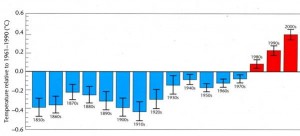
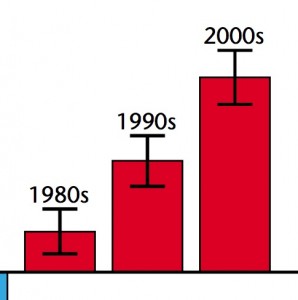
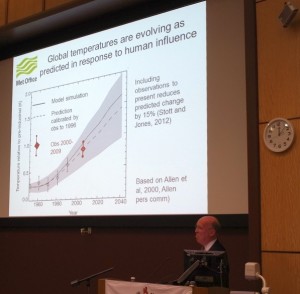
It is obvious there is no pause. It is essentially this data that the head of the UK Met Office, John Hirst, used in a recent lecture. Global warming is taking place at precisely the rate expected.
But there is another way to look at this data.
Firstly, the data in the Met Office graph has been cherry-picked through the process of dividing it into decades. As I have said before the climate knows nothing of a decade which is a time interval that ultimately comes from the number of fingers we have. Imposing arbitrary points on the data set, like taking the start at 1980 and producing data for the 80s, 90s and 00s, is also cherry-picking and has the disadvantage of throwing away the most recent data. There is a different way to look at this data.
Let us look at the last three decades average global temperature but update the Met Office graph to Hadcrut4 (it used Hadcrut3). You will notice it is essentially the same showing a steady increase – the unchanging underlying rate of global warming.
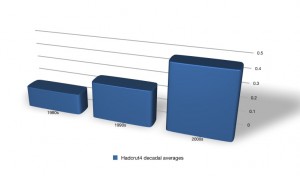
Now, bearing in mind the imposed constraint in the Met Office approach of decades with arbitrary start and end points, take the same Hadcrut4 data but this time use all the available data and work backwards in 5-year integrations.
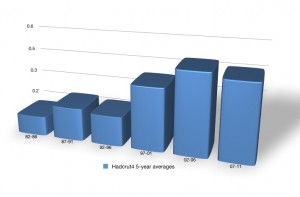
You will see it tells a very different story. There is now no consistent increase in temperature seen in the data. The mid-point in the Met Office graph is now seen to be the average of the two rather different middle points. What is apparent is that the data show the global temperature has changed between two levels. Each level, of fifteen years, is within one sigma of its mean, and the two levels are two sigma apart. A trendline drawn through the data is clearly unsatisfactory, as this diagram shows.
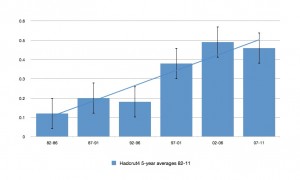
The data, displayed this way, reveal that far from showing a steady underlying rate of warming the global temperature has had two standstills, with curiously, the 1998 super El Nino delineating them.
These two ways of looking at the Hadcrut4 data (with the cherry-picking considerations) bring out differing aspects but averaging over a decade is giving a misleading impression of what the data actually shows – a well known problem with averaging. The global warming of the past thirty years – the current warm period – does not show an underlying constant rate. Temperature standstills are the norm.
Finally, it has been said that the 16-year standstill observed in the Hadcrut4 data since 1997 has been cherry-picked with its start and end dates. This is not so, the period is simply the answer to the question how far back does one have to go to see significant warming taking the errors into account. In fact, start and end dates are irrelevant, only its duration is important, not where it occurs in the dataset.
SOURCE
First time climate ignored in Presidential debates since 1984
Has Al Gore's Life Been in Vain?
It is very surprising to see three presidential debates and one Vice Presidential debate pass without a single mention of climate change. This is the first time this has happened since global warming hit the national stage in 1988.
Global warming activists are justifiably outraged by this. After all, Obama declared in April of this year to Rolling Stone that he would make global warming a key campaign issue in 2012. Obama let down a key part of his political base by going silent on climate.
What happened? How did climate change get reduced to a comedic punch line in the 2012 presidential campaign?
The answer is clear. The man-made global warming fear movement never overcame having a partisan figure like Al Gore being its public face and suffered from having the scandal ridden and distrusted UN IPCC as the source of its science.
Adding to these woes is the global economic slowdown and the fact that the Climategate scandal had massive consequences on public opinion and there was a collapse of the UN climate treaty talks.
In addition, the continued disintegration of the warmists climate claims by real world data and in the peer-reviewed literature make attempting to scare the public into climate 'action' virtually impossible.
Perhaps the most important factor in the climate silence in 2012 presidential race was a result of the forced vote in the House of Representatives to pass a cap-and-trade bill in 2009 which helped fuel the rise of the Tea Party movement in the U.S. No longer could a politician regurgitate the standard global warming claims of consensus and the need to 'act' without facing laughter and derision from angry crowds.
It is finally time to say RIP man-made global warming fears in U.S. politics?"
More HERE
Scorning the propaganda of fear
When a celebrated French philosopher from the centre left assails the “despotic” politics of environmental fear he should expect a dressing down from his climate change-conscious comrades.
But Pascal Bruckner has incited such fury with a diatribe against green prophesiers of imminent planetary ruin, the reaction has surprised even this veteran of the trans-Atlantic culture wars.
“The planet is sick. Man is guilty of having destroyed it. He must pay,” is how Bruckner caustically portrays the received wisdom on environmental “sin” and damnation in his latest book Le fanatisme de l’Apocalypse (The Fanaticism of the Apocalypse).
“Consider .... the famous carbon footprint that we all leave behind us,” he writes in his introduction. “What is it, after all, if not the gaseous equivalent of original sin, of the stain that we inflict on our Mother Gaia by the simple fact of being present and breathing?”
Subtitled Sauver la Terre, punir l’Homme (Save the Earth, Punish Human Beings) the book rails against a peculiar Western malady. Yes, concerns about the environment are legitimate, Bruckner asserts, but catastrophisme is transforming us all into children “put in a panic in order to be better controlled”.
It is a feistier-than-usual polemic for Bruckner, a leading member of France’s “new philosophers” who emerged from the 1970s left with searing critiques of Marxism. Later this year, it will be published in English as Fanaticism of the Apocalypse by Polity, Cambridge, translated by Steven Rendall.
As the Jesuit-educated philosopher sees it, extreme climate change alarmism, with its warning bells chiming “The end of the world is nigh, repent ye”, represents a worrying new doctrine of ideological purity that even has totalitarian overtones.
Worst of all, Bruckner argues, these “political commissars of carbon” have “betrayed the best of causes” and turned the discourse of ecological terror into the “dominant ideology of Western society”.
Dividing his argument into three sections, provocatively titled “The Seduction of Disaster”; “The Anti-progress Progressives”; and “The Great Ascetic Regression”, Bruckner scorns the peddlers of the “propaganda of fear”.
It is a muscular thesis delivered in typical elegant Bruckner style, citing philosophers, playwrights, novelists, political theorists and green activists from Martin Heidegger to Goethe, Moliere, Gustave Flaubert, Hannah Arendt, and France’s Yves Cocher.
However since the book appeared in French late last year, Bruckner has been pilloried in certain quarters as a reactionary turncoat aiding the worst climate change deniers. He has seen some publications that traditionally laud his work decry Fanaticism of the Apocalypse as hedonistic, deluded and dangerous.
“Le Monde devoted four pages to say to what extent my book was bad, false and full of lies, which is rather curious,” Bruckner says, with a slight edge to his voice, as we are ushered into an upper room in his local cafe, Le Progres, in the Marais neighbourhood of Paris. When his last book, The Paradox of Love, a reflection on the vicissitudes of the modern God of “Amour”, was released in 2009, it was critically acclaimed and became a bestseller.
“But I took a risk,” he explains of his latest controversial work. “It was [written in] a fit of anger. I went against today’s dominant ideas. There is widespread ‘greenwashing’ including in our thinking. The dominant passion of our time is fear.”
One blistering assessment, in Liberation newspaper, was headed “The Fanaticism of Denial”. The article accused Bruckner of being a pleasure-addled baby boomer stuck in pre-global warming nostalgia for the insouciant Trente Glorieuses, the 30 years of postwar French prosperity before the 1970s petrol shock.
The philosopher insists he cannot be classified as a climate change negationist – in fact the opposite, because he decries the virulent strain of denial among US Tea Party radicals and even mainstream Republicans.
“I do not attack ecology per se,” Bruckner says of his book. “I attack that degraded religion which emerges from it and turns into a culture of fear, hatred of progress and well-being.
“Why must we renounce all the joys of life under the pretext of global warming?”
More HERE
Australia: Another "Green" firm folds -- messily
The Federal Court is being asked to decide who owns more than $600,000 worth of solar credits left after a Canberra renewable energy firm went into administration earlier this year.
Enviro Friendly Products owed more than $750,000 when it went into administration in January.
Liquidator Worrells Solvency and Forensic Accountants wants the court to direct how to deal with the solar credits, known as STCs.
Issued by the Commonwealth government's Clean Energy Regulator, they are trading at a little over $30 a certificate and collectively are worth more than $600,000.
Klaus Matthaei, one of 260 customers issued with certificates, said customers included pensioners who had borrowed money to buy solar panels or solar hot water systems and still had quite a lot to pay back.
In documents filed with the court, Mr Matthaei has raised concerns that many customers were unaware of the court proceedings, and that he had tracked down 59 other customers who had little idea of what was happening.
Also, Mr Matthaei said 15,000 STCs worth $475,000 were missing and those funds should be reimbursed before any other creditors were paid.
He told the court the remaining STCs should be treated as separate from the assets of Enviro Friendly Products and administered by the eligible beneficiaries and the profits distributed among them.
"The cost of the missing STCs should be claimed from the liquidation of the company and if necessary from the assets of the directors," he said in his statement to the court.
Mr Matthaei told The Canberra Times he and his wife spent about $24,000 on panels and believed they would get back $8000 from the credits over 18 months.
Worrells Solvency partner Stephen Hundy said customers were entitled to a certain number of certificates depending on the size of solar hot water or solar panel systems they bought.
They had been given the option of assigning their rights to an agent.
EFP was a registered agent and some of those rights could have been assigned to the company to create certificates.
He said the company indicated to customers they would register the 21,000 certificates and hold them on the customers' behalf, even though they were registered in the company's name.
"The first thing we need the court to find or direct, is whether they were certificates held in trust for the customers.
"As the liquidator, we're not putting any positions forward, we have simply put facts before the court and provided options how to deal with certificates, and because different customers are affected in different ways.
"Some no longer have certificates in the system. Some still have them in the system, in the company's name."
Mr Hundy told The Canberra Times earlier this year factors contributing to the demise of Enviro Friendly Products included changes to the ACT government's feed-in-tariff scheme, which ended abruptly in May.
At the time the government said the feed-in tariff contributed to growth in the ACT solar market, and interest was mostly driven by the high level of assistance from the federal government's solar credits program.
SOURCE
***************************************
For more postings from me, see DISSECTING LEFTISM, TONGUE-TIED, EDUCATION WATCH INTERNATIONAL, POLITICAL CORRECTNESS WATCH, FOOD & HEALTH SKEPTIC, AUSTRALIAN POLITICS, IMMIGRATION WATCH INTERNATIONAL and EYE ON BRITAIN. My Home Pages are here or here or here. Email me (John Ray) here.
Preserving the graphics: Graphics hotlinked to this site sometimes have only a short life and if I host graphics with blogspot, the graphics sometimes get shrunk down to illegibility. From January 2011 on, therefore, I have posted a monthly copy of everything on this blog to a separate site where I can host text and graphics together -- which should make the graphics available even if they are no longer coming up on this site. See here and here
*****************************************






 Jim Hansen and his twin
Jim Hansen and his twin


No comments:
Post a Comment